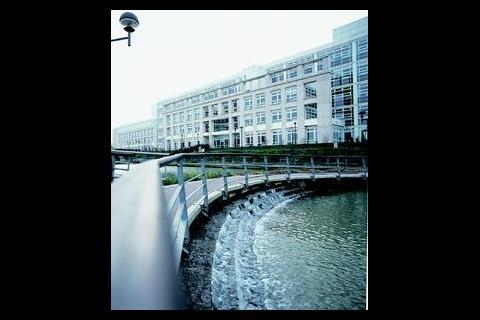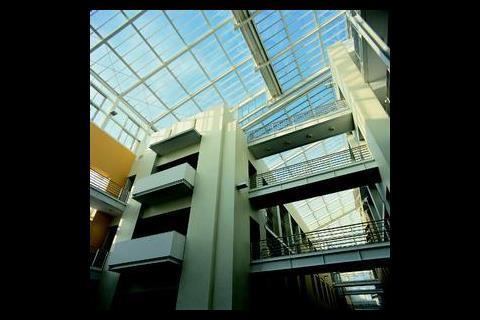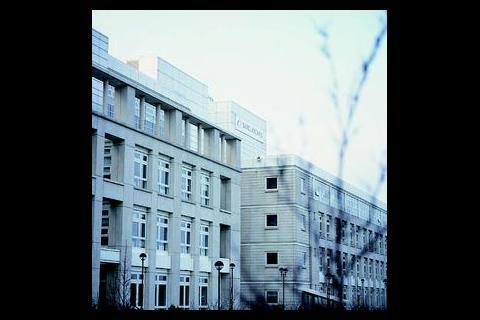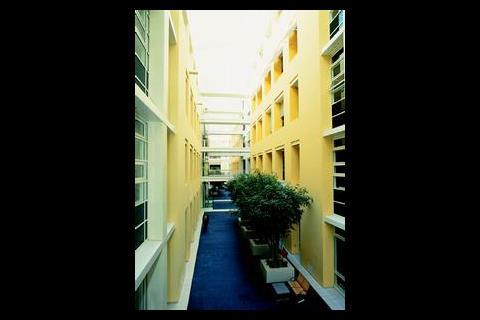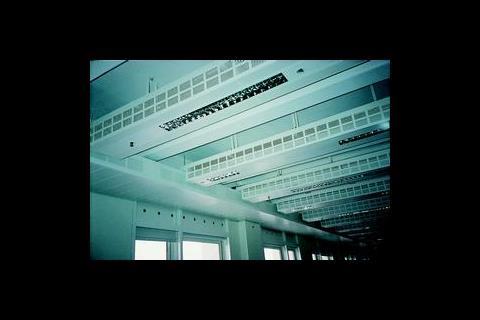Barclaycard's brief for its new headquarters building in Northampton seemed to ask the impossible. The PROBE team investigates if it achieved its goal.
Barclaycard's brief for its new headquarters building in Northampton seemed to ask the impossible. Conventional wisdom says that prestige offices cannot be squared with green engineering – prestige being associated with waste, and low energy with restraint.
The achievement of an 'excellent' BREEAM rating at the design stage seemed to square these two circles. It showed the developer was committed and that the design team had responded with a mix of conventional and distinctly unconventional low energy services: peak-lopping ammonia chillers, active chilled beams, exposed mass and mixed-mode mechanical and natural ventilation.
But have the building's environmental credentials been borne out in practice? Are the occupants happy with the mixed-mode operation and the building's broader range of environmental conditions? Moreover, did the developer's courage in low energy architecture create status or austerity?
Full details of the building's construction are given in the earlier Building Services Journal article, 'Squaring Two Circles'1. In brief, the development comprises a series of three staggered linear blocks on an east-west axis, connected by a 260 m internal street. The collection of three and four-storey offices are 15 m deep either side of the 9 m wide, glazed street.
Unusually for this kind of building the office facades are open to the street, except on the top floor where windows prevent the reverse flow of warm air. Ceiling heights are generous, ranging from 3·55 m to 4·3 m depending on the floor.
Most of the office space was designed with the speculative market in mind. A secure credit card department is on a lower ground floor, while the staff dining facility is on the ground floor of the east wing.
Representing a growing trend in information technology, there is no mainframe computer suite. Instead there are 12 data communication rooms distributed around the building. Only one has a dedicated cooling system. The remainder rely on central services.
The north elevation looks out over three linked lakes which, among other benefits, provide a source of (nominal) free cooling for the chilled beams.
<B>Basics of the services design </B>
Permanent natural ventilation is provided by a series of 45 mm diameter plastics tubes sized to give 5000 mm2/m of facade. These go through the lintels above the fanlight windows. The fanlights are manually openable using a worm gear. The central windows are fixed while lower panes can be opened using conventional handles. In warm weather, forecasts downloaded from the Internet inform security staff whether they should open these windows for the night.
The high-level windows in the street are operated by pneumatically-driven rams and controlled by the Serck building energy management system (bems) according to temperature, wind and rain setpoints. As part of the mixed-mode strategy, a back-up to the natural ventilation is provided by variable speed mechanical ventilation via floor diffusers. This is triggered by air quality sensors or any average floor temperature in a vertical block exceeding 23°C.
Heating is provided mainly by perimeter radiators (fitted with thermostatic radiator valves) supplied from two condensing gas boilers. Two hot water boilers supply hws to the kitchens via plate heat exchangers.
Cooling in the offices is by chilled beams. These are either cooled indirectly by lake water or directly by two 1000 kW ammonia chillers. The basic strategy is to use lake water when it is under 18°C and the chillers when the lake is warmer than this setpoint. While each ceiling coffer has a chilled beam, only half are fitted with coils. This makes it easy for extra cooling to be accommodated should the need arise.
The design capacity of the building was around 2250. Around 2400 are currently in occupation and there is a 6% rate of absenteeism. Density varies, but the averages is 11.5 m2/person, with one pc per desk. Facilities management is conducted by Barclaycard Business Services, with certain functions contracted out to Drake & Scull Technical Services.
<B>Operational experience: heating and cooling</B>
The building has suffered some heating problems. Elements of the fabric were reported to be cold and this was confirmed by infrared imaging. Window frames appear to have cold bridges and some horizontal cavity wall closures are leaky due to a poor design detail.
Occupants are reproached for failing to understand the function of thermostatic radiator valves (or display wilful ignorance) so that many valves are set to maximum or 'frost'. As a result of the PROBE study, the building managers are investigating the retrofit of thermostatic radiator valves with internal limit stops.
The design intent was for cooling to be activated when the average temperature on any floor exceeded 23°C. In practice, the maintenance team try to hold off the chillers to save energy. As the lake is generally too warm to be used directly in summer the chilled beams are rarely utilised. Instead, effort is made to maintain temperatures by night cooling.
The maintenance team also tries to keep the chilled beams off in winter (when they can be cooled by lake water). However, this may be a false economy as the pumps for the primary and secondary lake water circuits are on continuously to meet the cooling loads of the computer rooms and the credit card bureau.
In fact, when neither the beams nor frost protection require the lake circuits to run, it would be more efficient to use the small chillers dedicated to this purpose.
Summer temperatures have been judged to be generally satisfactory. Occupants have reported some overheating, but there has been no call to fit extra cooling coils to the empty beams. In practice, the beam capacity is less of an issue than the cost/benefit of running the main chillers.
Overheating in winter could be alleviated by opening windows, but the discomforting effect of cold window surfaces means that the perimeter radiators are brought on even though people in core spaces are too hot. This forces the simultaneous operation of beams and radiators.
<B>Operational experience: ventilation </B>
The natural ventilation strategy has worked well. In the early days, some street window operating mechanisms suffered problems when the self-tapping bolts for the actuator ram fixing plates worked loose. These were replaced with stronger fixings.
In the offices, occupants favour the main windows over the fanlights for sheer ease of use, even though the latter would be more effective. The mechanical displacement ventilation is designed to be triggered by mixed gas or space temperature sensors. Doubts about the efficacy of the sensor, combined with few complaints of poor indoor air quality, has made the maintenance team wonder if the gas sensors have ever switched on the ventilation. Barclaycard is considering changing to CO2 sensors as they are more reliable, easier to recalibrate and cheaper over ten years.
The vertically zoned ducts were designed to equalise air supplied to each floor. This was the only balancing mechanism, and in practice more air was delivered to the ground floor than the top floor. This was resolved by reducing diffuser density at the ground level and increasing it on the top floor.
Top floors are inherently prone to overheating as the temperatures in the monopitch atrium roof can reach 40°C. With the vertical zoning, this can cause lower floors to be over-cooled when the top floor sensors trigger mechanical ventilation.
Some 3500 tubed trickle ventilators were fitted above the windows but, due to complaints from staff, about 1200 have been blocked. A further 1000 trickle vents have been fitted with de-flectors to stop cold air dumping on occupants. The pressure test results suggest that even with one-third of the trickle vents permanently blocked, the leakage rate is still at least 50% higher than BSRIA recommends for a naturally ventilated building.
<B>Operational experience: lighting </B>
All offices have fluorescent luminaires with passive infrared occupancy-sensing detectors and two-stage dimming. Since occupation the dead band has been widened from 2·5 minutes to 12·5 minutes. This ensures the detectors pick up slight movements from occupants working on computers. Lighting levels are 350 lux.
Most complaints have been about the brightness of the lighting, even though the light level is 350 lux – 150 lux lower than the occupants' former offices. The building managers speculate that dissatisfaction with lighting seems to be less to do with the lamps and more due to the pressure of work and masses of white, laminated paper spread across the desks. As the old offices also had pull cords, loss of personal control rather than lighting level may be an issue.
The building managers have identified a split between those who had control in the previous building and those who did not.
<B>Energy and water consumption </B>
As the building is a prestigious head office, its energy and water consumption have been compared to the Type 4 building type in ECON 19, even though it is not fully air conditioned.
Gas is used for hws in the kitchens and space heating. A detailed analysis of gas bills shows that, in the 12 months from June 1998, total gas consumption was 113 kWh/m2 (treated floor area). It is estimated that 96 kWh/m2 is for space heating and 17 kWh/m2 for catering (relatively high due to the large dining-room and over 2000 meals being served daily).
Normalised for standard weather conditions of 2462 degree days, the gas consumption for space heating is 111 kWh/m2 and the total gas consumption 128 kWh/m2. This is 12% above the Type 4 good practice benchmark of 114 kWh/m2, but only 60% of the typical value of 210 kWh/m2.
This achievement is largely due to the avoidance of tempered heat requirements of extensive high volume mechanical ventilation. Also, office internal heat gains are relatively high, and the condensing boilers can be turned off in summer.
A detailed analysis of electricity bills shows that, in the 12 months from November 1998, actual electricity consumption was 204 kWh/m2 (treated floor area). This means that electricity consumption is 13% below the unadjusted Type 4 good practice benchmark of 234 kWh/m2 and only 57% of the typical figure of 358 kWh/m2.
Low fan power has helped. The designers set a target of 1 W/litre/s, and the installed fan power of 4 W/m2 is well below the good practice level of 8 W/m2. Natural exhaust via the atrium helps by negating the need for extract fans.
Although pump energy is reduced by variable speed drives, operating hours are high as the lake pumping circuits are on for much of the winter.
At 9 W/m2 installed lighting loads are better than good practice, as is lighting efficacy. The estimated maximum running hours for electric lighting is just under the good practice level of 3500 h/y. Presence detection ensures that the use of lighting is restrained to the good practice level of 70%. This means that full load hours are 2400/y, making office lighting consume just 18 kWh/m2/y.
An office equipment load averaging 12 W/m2 pervades far more of the building than normal. This is a consequence of highly efficient space planning. Operating hours are double good practice levels, largely because computers are left on overnight so that network maintenance can be carried out. The result is an electricity consumption of 73 kWh/m2 – over twice the typical level. For various reasons very few computers have their powersave functions enabled. Just switching off the screens for 108 h/week would save 34 kWh/m2 or around £50 000/y.
In terms of C02 emissions, the building comes in at 114 kg CO2/m2 – 9% below the good practice figure. Compared with other Type 4 offices studied by the PROBE Team, this is excellent performance.
The building does not have a central computing facility, which constitutes a substantial element of the benchmark energy consumption. However, there is no escaping the finding that the estimated energy used for the building services is 75% of the good practice benchmark, and less than 40% of typical benchmark.
The Serck bems is operated by Drake & Scull, who demonstrated good familiarity and proficiency with the system. One flaw is a lack of feedback from controlled equipment. This means visual confirmation is often required to ensure that plant has switched on or off, and that the street windows have opened and closed.
The firm has no specific energy management remit, although it is asked to maintain services as economically as possible. Energy consumption is monitored by meter readings, but no targets have yet been set. Barclaycard nevertheless operates a strong environmental policy and holds quarterly review meetings. This commitment has led to specific actions, such as changing the credit card bureau cooling from the main chillers to dedicated coolers.
Total water consumption is some 19 000 m3/y, which equates to an annual usage of about 8 m3/person. This is 20% below the 10 m3/person benchmark for an efficient office.
<B>The occupant survey: comfort </B>
A survey for building occupants was carried out at the beginning of December 1999. Two hundred and eighty office staff were asked to fill in the standard PROBE questionnaire, of which 150 were first floor occupants and 130 from other parts of the building. The response rate was 91% for the first floor sample and 82% for the wider building population.
In terms of the occupant profile, the building has more women than usual and staff have fewer seats by windows. Staff are also accommodated predominantly in large workgroups in fairly regimented open-plan layouts. Both characteristics may make staff more critical of their conditions. Most staff had worked in the building for more than a year, and churn rates are low compared to other buildings. Higher churn tends to mean higher satisfaction, so the static population at Barclaycard will have tended to reduce the comfort scores.
The levels of occupant satisfaction with the building's environment. The benchmarks shown are based on scores from a recent sample of 50 UK buildings studied by Building Use Studies, so they represent average rather than good UK conditions.
On comfort, Barclaycard scores consistently better than the benchmarks, with summer temperature and air quality, and lighting all being significantly better. Negative observations include lack of temperature stability (which some respondents said affected productivity), lower floors too cool while upper floors are too warm, and the seeming indifference of system settings to weather conditions.
In terms of air quality, the building comes out as typical for winter conditions, although it is perceived to be more humid and stuffy and temperatures are felt to vary. For summer, the building is more comfortable and considered to be significantly cool – something rare in the UK.
Natural lighting is marked down by the occupants and, as in most buildings, there is too much electric lighting. The occupant perception of glare is typical for UK buildings.
The score for noise from other people is higher than that from colleagues, indicating problems with circulation and space planning.
<B>Control and response </B>
Scores for perceived control are all significantly lower than the benchmark figures, which themselves are well below the scale mid-point. This is balanced by good scores for quickness of response, with that for cooling being significantly better than the benchmark.
The forgiveness score is a measure of the extent to which occupants tolerate some of the reported problems. Here, forgiveness is above the benchmark, so Barclaycard's occupants may be giving the building the benefit of the doubt in some cases.
The building management responds to users' requests for assistance through a telephone help desk. This administers reactive maintenance as well as room bookings and catering requirements for meetings. Faults and complaints are logged on a database and passed to in-house maintenance staff or a contractor.
The required response time is decided by the service desk operator in a range between emergency (1 h) and ten days. Issues are categorised by subject, for example heating, lighting, general maintenance, windows, etc. Building services and lighting issues are always given a 1 h response time.
The service desk is currently averaging 200 calls/day, of these about 4-8 concern hvac or lighting. Interestingly, only 25% of those who requested changes to systems rated the response time as fast, while 24% rated it as effective. Both these scores are significantly lower than the benchmarks.
Occupants express positive views on the building's design and the way their needs are met, showing that staff are happy with the facilities. The health score, though, is low. This may be due to the time of year the survey was carried out, but the question asks whether people feel more or less healthy when they are in the building. As this is designed to solicit a relative answer, it should not be sensitive to the time of year. This needs further investigation.
Study of the survey samples shows that the building may be better on the upper floors, or at least on levels above the ground floor.
<B>Overall building performance </B>
There is nothing exceptional about the occupants' views of the building. Most of the occupant survey scores are close to the averages or mid-points, and this can be explained by a cluster of negative factors which push the building's overall score down. These include large, open-plan areas with lack of differentiation between workgroups, the lack of seats near windows, and the absence of personal control for the majority. Noise distraction is also a factor, along with intrusive circulation routes.
While occupants use words like impressive, pleasant, airy and bright to describe the building, criticisms include car parking, intrusion of doors, a lacklustre reception area and style over substance (ie too much emphasis on image and not enough on usability – a common flaw).
A lack of meeting rooms was mentioned by a significant number of respondents and there was a lot of negative comment about storage arrangements. It seems that there is not enough personal storage, especially for coats.
Note that the survey did not measure staff morale (a redundancy programme was underway at the time of the survey) nor the type of work that was being carried out.
On the energy front, it is pleasing that at last the PROBE Team has found a prestige head office which produces CO2 emissions below the good practice level – an exceptional performance and a noteworthy success for the design team, the client and the facilities staff. This has been achieved by highly evolved climate-responsive architecture, intrinsically efficient building services and diligent and committed operators.
The building services, though, are far from straightforward, both in terms of their differences from conventional systems and the range of options they continually present to the building operators. In the wrong hands this might have been a recipe for either high energy use or serious occupant dissatisfaction – probably both. That neither have resulted is a credit to the operating team. Also to the client, who has ensured the critical continuity of people involved in managing the building, from the design stage through handover to long-term operation.
The BRE pressure test
The BRE carried out a fan pressurisation test of the Barclaycard head office. Four fans were used to pressurise the building’s massive envelope of 21 000 m2. These were the BRE’s large fan pressurisation system, BREFAN, and the three medium-sized BREFANs. To date this is the largest building the BRE has tested using these fans. Prior to the test the mechanical ventilation plant was shut down and the large number of supply and extract grilles sealed using polythene and duct tape. When first occupied, the building had 3500 permanently open trickle vents. Some of these have been sealed and others have been fitted with internal deflectors. Those left open were not sealed for the test as they are considered part of the base ventilation system and cannot be closed in normal operation. The results of the test gave an air leakage index for the building of 17·8 m3/h/m2 at a pressure differential of 50 pa. As plotted on the BRE/BSRIA database, the building is classified as just above the average benchmark value (figure 5). Only a very brief air leakage audit was possible owing to the time taken to prepare the building for the test. As expected, a lot of air was passing through the permanent ventilators, especially those that were fully open. However, the screens on the inside face of the ventilators were dust-covered, which may have reduced their air flow rate. A sample of the high-level, pneumatically-operated windows in the atrium showed them to be well sealed, with only slight leakage at some bottom corners. However, air leaked into the capped-off cavity under the bottom of the atrium window frames and around the vertical columns. Leakage was also found at the bottom of the sealed windows on level four. A selection of office windows was tested. These were found to be well sealed when closed, though some opening toplights leaked when the window was not shut tight against the draughtproofing. Air leakage was also detected through the window frame joints and was noticeable above the trickle ventilators at the junction with the columns. Brian Webb is a senior scientist and heads the Airtightness Technical Consultancy service at the BRE. This pressure test was funded by the DETR as part of the BRE/BSRIA/Building Services Journal initiative on improving building airtightness.Key design lessons
1. A low energy, prestige officeAt last the PROBE Team has found an ECON 19 Type 4 office with CO2 emissions 9% below the good practice level. The absence of a large computer suite is balanced by high energy use from the desktop pcs. Most significant, perhaps, the CO2 emissions for all building services is 25% better than good practice. 2. Life cycle costing avoids false economies
The original specification called for CO2 sensors, but these were downgraded to much cheaper mixed gas sensors. The former may cost three times as much, but they can be recalibrated on-site every five years, while the latter require replacement or recalibration off-site every two years. 3. Manual versus automatic windows
Barclaycard shows that neither option is a panacea. Automatic with manual override may be ideal but is expensive, although even top-hung windows must be closed at the end of the day. Manual opening should deal with any winter overheating, but typically staff in core areas are too hot while those at windows need heating to counter cold surfaces. 4. Vertical versus horizontal zoning
The degree of resolution when creating zones is a compromise between customised control for each space and the complexity of the pipework and controls. As in most buildings the top floors at Barclaycard are prone to overheat due to temperatures at high level in the street. Zoning to enable independent control of top floors should be considered by designers. 5. A success for mixed-mode operation
Barclaycard shows that a choice of operating strategies can avoid the wasteful operation typical of prestige offices. The use of chillers and chilled beams as peak-lopping devices appears to be a high capital cost solution, but only because the services are rationed to a few days or weeks in the year when occupants might experience discomfort. This begs closer analysis at the design stage of overheating criteria and occupants’ likely response to higher temperatures.
Designer’s response to the feedback study
The client’s brief was for an environmentally-friendly, naturally ventilated, intermittently occupied building, writes David Arnold of services design consultancy Troup Bywaters & Anders. As designers of the building services, we told the client’s project manager that we estimated the energy use of the mixed-mode design solution would only use 60% of a typical comparable building. As a measure of caution, he told the client the energy use would be 75%. The PROBE study appears to justify our initial estimate, but if we had known how the building was ultimately going to be used we would have probably been more conservative in our estimate. As m&e designers we do not (indeed, cannot) claim responsibility for achieving the goal. We were fortunate that we had a committed client prepared to accept different ideas, an architect with sympathy for engineering services and integrated design solutions, and ultimately a building operator keen to exploit the energy minimising potential of the building and systems. In response to the key design lessons: A low energy, prestige office:Significant factors in the exceptional performance of the building, in terms of energy use, were the integration of thermal storage in the building and cooling pond, solar shading and low transport energy use for the air and water systems. With 75% of the ceiling slab exposed and closely coupled to the occupied space, this seems to provide about the right balance for overnight cooling. Life cycle costing avoids false economies:
CO2 sensors were specified originally but replaced by inferior detectors as part of a cost saving exercise to maintain the budget. With hindsight it was a mistake. Manual versus automatic windows:
If the budget had been greater we would have used automatic windows with local controls. They were considered but omitted on cost grounds. Automatic window control would have increased control of overnight cooling but I am not certain whether it could have been justified on life cycle costs alone. Vertical versus horizontal zoning:
This is a lesson well learnt. All buildings of this type have a problem with overheating on the upper floors. We were aware of the problem and were of the opinion that the temperature difference would be within the design limits. Generally this was the case, but it led to complaints and we would use floor by floor control in future. A success for mixed-mode operation:
Mixed-mode has proved successful but it has been complemented by the pro-active involvement and control of the facilities team. We need to develop more robust controls. The design strategy for chillers was that they would only be used for a few days per year in a typical summer. However, they also provide the client with an insurance against the effects of further climate change. As designers we are in a privileged position to have the feedback from the PROBE study. It is complimentary about many of the design features but several lessons have been learnt. Hopefully, these will be used by designers in a less privileged position.
Downloads
CO2 emissions and electricity consumption data (fig 1)
Other, Size 0 kbCO2 emissions and electricity consumption data (Fig 2)
Other, Size 0 kbResults from occupant satisfaction survey (fig 3)
Other, Size 0 kbResults from occupant satisfaction survey (fig 4)
Other, Size 0 kbOverall building performance (fig 5)
Other, Size 0 kb
Source
Building Sustainable Design
Reference
<B>Further reading</B> 1Field J, 'Squaring two circles', Building Services Journal, 4/97. Energy Consumption Guide 19: Energy use in Offices, DETR, 1/00.
Postscript
The PROBE Team for the investigation of the Barclaycard headquarters comprised Robert Cohen of Energy for Sustainable Development, John Field of Target Energy Services and Adrian Leaman from Building Use Studies. Thanks are extended to the Barclaycard facilities team of Nigel Hanwell, Toni Panebianco and John Sloman.
PROBE is a collaborative research project conducted by Building Services Journal, co-funded under the Department of Environment, Transport and the Regions' Partners in Innovation (PII) initiative, and managed by Energy for Sustainable Development.





















